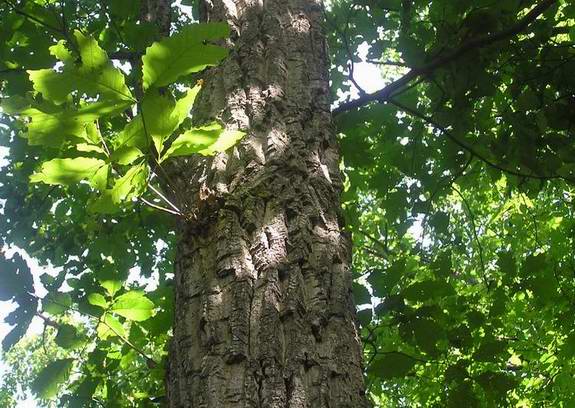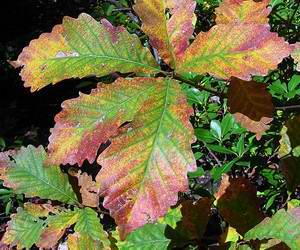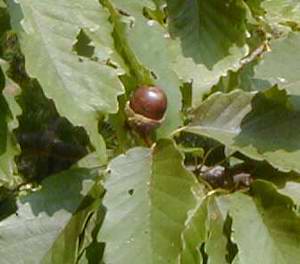|
Return to Hiker's Notebook Home Page
Common Name: Chestnut Oak, Rock Chestnut Oak, Rock Oak, Mountain Chestnut Oak, Tanbark Oak, Basket Oak, Cow Oak - The leaves have lobed edges which are reminiscent of the leaves of the American chestnut tree (Castanea dentata); it is called the chestnut oak to emphasize this similarity.
Scientific Name: Quercus prinus - The generic name is Latin for oak tree. The species name is less well defined and has numerous possible etymologies. It is either a misapplication of the Latin word primus, meaning 'first' or the Greek word prinos meaning 'evergreen tree.' As neither derivation makes any sense, it is not unlikely that Linnaeus selected it randomly to distinguish it from the several other known oak species. It is also known as Q. montana, or oak tree of the mountains, which does make sense.
The chestnut oak, as the alternative names rock chestnut oak and mountain chestnut oak suggest, is an oak tree of the rocks, notably those found in mountainous upper elevations. It is one of the most abundant trees of the mountainous ridges of the Appalachian Mountains extending from Maine to Georgia. It is particularly well suited to rocky upland forest and xeric ridges; its preponderance in this sere, nutrient deficient environment is reflected in its diminutive size, growing to a modest height of about 65 to 80 feet. The chestnut oak is a rather stunted cousin of the venerable white oak (Quercus albus) and is accordingly not considered to be a particularly valuable lumbering tree; the wood is typically sold as an inferior "mixed white oak" category. The bark, however, is prodigious; the thickest of any of the North American oaks. In older trees, bark is a key recognition feature, as it has an incongruous deeply ridged and roughened profile, rather like a disheveled black locust tree (Robinia pseudoacacia). There are four species of trees that comprise the chestnut oak group. In addition to Q. prinus (or alternatively Q. montana), they include the swamp chestnut oak (Q. michauxii), the chinkapin (sometimes chinquapin) oak (Q. muehlenbergii), and the dwarf chestnut oak (Q. prinoides). All are characterized by leaves of similar shape, described in the lexicon of botanists as crenate, having a scalloped margin with rounded tips at each projection. This similarity makes distinguishing the four different trees of the chestnut oak group difficult without an expert knowledge of the vestiture (covering) of the leaves, the shape and size of the acorns, and the color and texture of the bark. The four species are accordingly frequently misidentified in the literature to the extent that some botanists favor dropping the designation Q. prinus in favor of the less compromised Q. montana. For all of the confusion, the habitat in which the tree is found is a good indicator. If it is on a mountain ridge, it is a mountain chestnut oak, hereafter Q. montana.
The confusion in the identification of the four chestnut oak species extends to the different common names that are frequently arbitrarily assigned to one or another species without regard for the relevant cultural origin. This is particularly the case with the swamp chestnut oak (Q. michauxii), which some botanists have considered to be the same species as the chestnut oak. The swamp chestnut oak, as its name implies, thrives in moist habitats, known colloquially as wet bottomlands; it is an important source of lumber in the southeastern United States where it can frequently be found in dense, single species stands. It's wood was used to make splints that were formed into baskets that were purportedly used in the antebellum South to carry picked cotton from the fields, the tree earning the sobriquet 'basket oak' in the process. Swamp chestnut trees grow along the streams adjacent to cow pastures, their sweet acorns providing provender for the grazing cows. This is the etymology of the common name 'cow oak.' Due to the verisimilitude with Q. michauxii, the chestnut oak is sometimes mistakenly called either basket oak, though it was never used for baskets or cow oak, though it was likely never eaten by meandering cattle unless they happened to venture into the mountains.
The chestnut oak is called tanbark oak with good reason, as it has thick, tannin-rich bark that was widely used in the treatment of animal skins to make leather. The word tannin is from the ancient Celtic word tannum meaning oak bark, establishing the oak as the predominant source in prehistory, its importance reflected in the use of the term tanning for the entire leather treatment procedure. Leather tanning begins with cleaning and scraping an animal hide to the stable condition called rawhide. The conversion of rawhide to leather is accomplished through the chemical action of tannin, a soluble astringent complex phenol that shrinks and stabilizes the proteins of the skin cells that are manifest in the pliability and consistency of the finished product. The use of chestnut oak bark in the tanning process is addressed by Jack and Carolyn Reeder in the book Shenandoah Secrets: "For two weeks or so each spring, bark could easily be peeled from chestnut, chestnut oak, and hemlock trees. This bark was in high demand because of its high tannic acid content, and local tanneries purchased all that the mountain people could supply for use in curing leather." There were also some local tannery's in the mountains, employing a relatively primitive tanning process. After the tanner cleaned and scraped the hides, they were soaked in a weak tanbark solution for several months before being placed in vats with alternating layers of bark. Over the course of about a year, the tannin gradually leached into the hides to cure the leather. It is likely that the use of chestnut oak bark in addition to the then more prevalent American chestnut bark for the tanning of leather gave rise to the naming of the one for the other. It is ironic that the widespread decimation of the American chestnut due to the chestnut blight fungus (Endothia parasitica) introduced from Asia in the early 20th Century has led to the spread of its namesake oak over the same forest regions. The Appalachian oak - American chestnut forest that once was dominant over vast stretches of the Appalachians was renamed the oak-hickory forest in the absence of the American chestnut. It has been suggested that portions of the oak-hickory that are dominated by the chestnut oak be reclassified as Appalachian chestnut oak forest.
The acorns of the chestnut oak are prodigious, growing to a length of over an
inch with a girth nearly as large; they are among the largest acorns of all
American oaks. Though good crops of chestnut oak acorns are relatively rare -
they mast
every 4 or 5 years in lieu of the normal oak mast cycle of 2 to 3
years - they are an important food source for animals. A good acorn crop has
been correlated to the variations in spring temperature and humidity, with a
colder May following a
|


 warmer
April (known as a dogwood winter in some regions) providing the best results.
In a mast year, a single chestnut tree can produce up to 300 pounds of acorns
while in a non-mast year, the yield is typically less than 10 pounds. By dry
weight, the average acorn contains 5.76 percent protein, 10.07 percent crude
fat, 78.9 percent carbohydrates, 0.15 percent phosphorus and 0.09 percent
magnesium with a trace of calcium. One acorn provides 15.7 kilojoules of
energy for metabolism, equivalent to the more familiar 3.75 kilocalories
(commonly called calories without reference to the kilo - thousand - prefix).
The acorns are considered to be sweet relative to other acorns and field
evaluation has shown that grey squirrels prefer them over white oak acorns.
The dissemination of acorns for the germination of new growth is dependent on
gravity and squirrels; however, field studies have shown that squirrels bury
only 0.5 percent of the available chestnut oak acorns (1 out of every 200),
presumably consuming the remainder directly. The survival of the chestnut oak
thus depends on the performance of its acorns; their large size and
thick-walled skin that retains moisture provide excellent nutrition for the
nascent plant; the overall germination rate of intact chestnut oak acorns is
90 percent.
warmer
April (known as a dogwood winter in some regions) providing the best results.
In a mast year, a single chestnut tree can produce up to 300 pounds of acorns
while in a non-mast year, the yield is typically less than 10 pounds. By dry
weight, the average acorn contains 5.76 percent protein, 10.07 percent crude
fat, 78.9 percent carbohydrates, 0.15 percent phosphorus and 0.09 percent
magnesium with a trace of calcium. One acorn provides 15.7 kilojoules of
energy for metabolism, equivalent to the more familiar 3.75 kilocalories
(commonly called calories without reference to the kilo - thousand - prefix).
The acorns are considered to be sweet relative to other acorns and field
evaluation has shown that grey squirrels prefer them over white oak acorns.
The dissemination of acorns for the germination of new growth is dependent on
gravity and squirrels; however, field studies have shown that squirrels bury
only 0.5 percent of the available chestnut oak acorns (1 out of every 200),
presumably consuming the remainder directly. The survival of the chestnut oak
thus depends on the performance of its acorns; their large size and
thick-walled skin that retains moisture provide excellent nutrition for the
nascent plant; the overall germination rate of intact chestnut oak acorns is
90 percent.